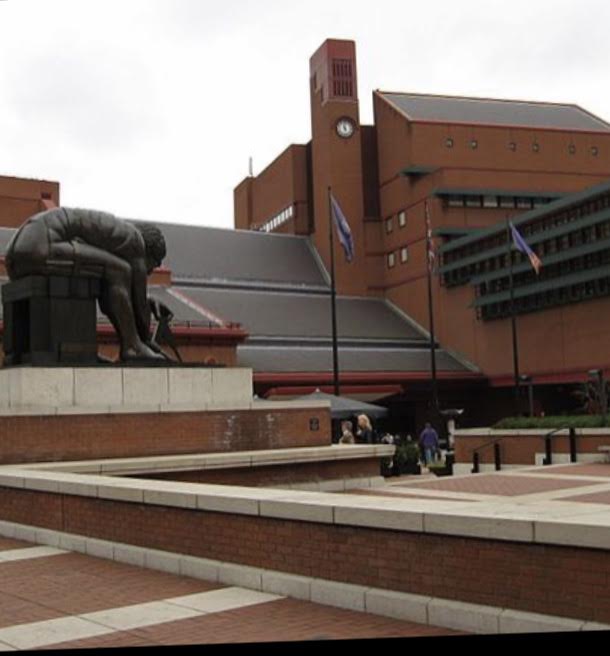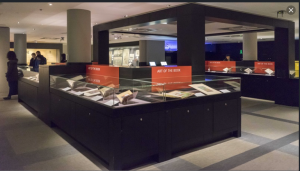
David took a job with Google DeepMind and moved to London in January, 2015. Google put him up in a two bedroom apartment for two months while he looked for a place of his own. Not wanting to let the second bedroom go a-begging, we went to visit the next month. It had been a long time since we visited London, but Dan didn’t want to see the regular tourist attractions and I sought advise from Cousin Sue and my London cousins. One suggestion was the Treasure Room of the British Library.
The British Library, separated from the British Museum in 1973, is a huge research and lending library, but also has a spectacular display of works on paper (or parchment) in a climate-controlled setting; wondrous, rare, world-famous works. We didn’t quite know the depth and breadth of the collection when we entered the room.
Dan ambled off, but David and I stuck together and commented on various objects as we wandered through, adding to our delight. We went straight for the Magna Carta, perhaps the most significant document in British history, it was forced on unpopular King John by his barons, granting them certain rights, but is considered to be the basis for the Massachusetts Constitution, written by John Adams and a precursor to the US Constitution. As such, is the first civil code of written laws. There are four copies in existence, two held by the British Library. I had actually seen a copy in 2014 at the Boston MFA in a small but meaningful display when it came on tour through the US. It is not an impressive-looking document; it is a small piece of parchment written in Latin, the ink faded. But I was overwhelmed with the import of its meaning, as were others at the MFA, lined up that day to see it. In fact, we were in awe of the power of the word to convey the law. It is good to reflect on that today with a president who seems to think the law does not apply to him. David and I were equally impressed looking at it that day, now more than four years ago.
We moved one space to the right and I found the document in Queen Elizabeth I’s hand condemning her cousin, Queen Mary of Scots, to death. For someone as enamored of the Tudor period of history as I am, this was the jackpot. Mary was the Catholic pretender to the British throne. Her grandmother was Henry VIII’s sister, sent north to marry the king of Scotland for political reasons, so she really was Elizabeth’s close cousin. Elizabeth, child of Anne Boleyn, raised a Protestant, was always considered a bastard by the Catholics of England, since Henry’s divorce from Katherine of Aragon was never accepted by the Catholic Church. Yet she was firmly on the throne and reigned successfully for 69 years. Elizabeth hesitated to kill her cousin, another anointed sovereign, until she had irrefutable proof that Mary was involved in a treasonous scheme to overthrow her. With this document in front of me, she doomed her cousin to death. Elizabeth died childless and was succeeded to the throne by Mary’s son, James VI of Scotland, who ruled as James I, uniting England and Scotland. Famous for the King James version of the Bible, he got his small revenge on Elizabeth by burying his mother in a grand tomb in Westminster Abbey opposite Elizabeth’s so they are united in death for all of time. He ushered in the Stuart dynasty.
The next document in the case was the papal bull excommunicating Elizabeth. I don’t think she cared that the Pope excommunicated her from a church to which she did not belong.
David and I moved around the dimly lit room. In another case, we found a first folio edition of Shakespeare. I don’t remember what play lay open, but that it was beautiful and significant for me, a former theater major who always aspired to play Juliet. We saw a first edition Ian Fleming James Bond novel next to Paul McCartney’s original hand written sheet music for “Yesterday”. I paused for a moment. This is perhaps my favorite Beatles song; a wistful, lovely melody. Now we know that Paul awoke with the tune in his head and wrote in “scrambled eggs” as a place holder until he thought up the words. The words are perfect. At that moment, when I saw them, I thought of something I was going through. I wished I could go back to “yesterday”, as I was at a turning point and felt like a magical time had slipped away. The song resonated for me in a certain way. It was even meaningful that it was next to 007. But we can’t go back, can we?
In a different section of the room were gorgeous Persian manuscripts and illuminated manuscripts from the Middle Ages. I studied such things in art history class. The paintings in them were master works.
We felt like we had done the whole room, but still hadn’t seen the Gutenberg Bible. We quietly commented on that to each other. Had we missed it somewhere? Where was it? We realized we were standing in front of it. We took it in with awe. The first piece of printing of the world. How marvelous! It sat open on a rack, and for preservation purposes, the open pages are frequently changed. Of course, we couldn’t read any of it, but we still marveled that we were seeing one of the rarest books in the world.
We found Dan and left the Treasure Room. We were hushed for a moment. There was a very busy Alice in Wonderland exhibit across the hall. We had had enough. We left, knowing that we had, indeed, seen many treasures.
Retired from software sales long ago, two grown children. Theater major in college. Singer still, arts lover, involved in art museums locally (Greater Boston area). Originally from Detroit area.




This is a great story, Betsy, especially since, in my ignorance, I was not even aware of there being a separate British Library, let alone the aptly named Treasure Room. And you beautifully describe seeing the treasures that are in there.
Indeed, as amazing as these treasures are, they are also humbling in terms of realizing how recent our own history is. However, assuming that your first picture is of the Library, my sense is that the building itself, at least on the outside, is a pretty dull modern structure.
I also loved that the Library recognized that not all treasures are modern. Indeed, while reading you write about it, I had a vague recollection of hearing the “Yesterday”/”scrambled eggs” story before. Love it!
Thank you for enlightening me and letting us all share in your exciting visit!
Yes, John, the building is modern in St. Pancras, built at the time it separated from the British Museum, large enough to hold its vast collections. And yes, in terms of the long view of history, we are youngsters. It has been sort of fascinating to see that the British don’t have a written constitution, only tradition to guide them and Boris Johnson has made mince meat of that lately. So they are in a stew over there too. Both our countries are governed by lying, corrupt blondes with bad hair. I suspect BoJo is a bit brighter than our guy, but equally driven by ambition.
Lovely story, Betsy. I like how you not only describe each artifact you looked at, but also relate it to British history, or your own life, or both. Very well thought out. I also appreciate that the reason you went to London was that David had a temporary apartment with 2 bedrooms, and you didn’t want the second bedroom to go to waste! Perfect excuse for a trip! Thanks for sharing it.
I thought for a while about this prompt, because there were so many ways to answer (as you’ll see in my responses to the various stories), but thought this was the most unusual, so wanted to share it here. As I believe I’ve said before, I really like history, which is an extension of our own stories, I believe. David is very well-grounded in history, beyond just European, so it is great to go to museums with him, as he is so knowledgeable. Glad you liked this one.
Thanx Betsy! I also was unaware of the Treasure Room, will definitely head there the next time in London!
The Long Room at Trinity College, Dublin. has comparable treasures, if you’ve never been, put that on your bucket list!
At the beginning of tour, I quickly saw the Book of Kells at Trinity, but that was it, as we were on a tight schedule.
Betsy, Years ago when I was in Dublin without Danny at Trinity’s Long Room I too saw one of those Magna Cartas. But perhaps it was on loan for an exhibit because years
later I was back in Dublin with Danny and took him to see it and but was no longer there.
Also remember seeing those 98 theses that Martin Luther nailed to the door of the Wittenberg church to usher in the Protestant Revolution and other amazing documents!
Ain’t travel grand!
I love this, Betsy. It is quite a history lesson, and I’m always up for learning more about the past. How amazing to see a first folio of Shakespeare, a first edition of James Bond, and (OMG) Paul McCartney’s sheet music for Yesterday. On top of that, you saw the Gutenberg Bible. This was truly a treasure room. I totally agree with what you said, “In fact, we were in awe of the power of the word to convey the law. It is good to reflect on that today with a president who seems to think the law does not apply to him.”
Thank you, Laurie. More and more it seems, the current occupant of the White House and those around him, do not comply with the laws of our land; truly frightening.
Amen Laurie.
Wow! A visit to the mausoleum of Anglo culture. Your vivid descriptions gave me a sense of what it must feel like to exist at the center of the Universe! I would have been stuck there for days!
While I detect a slight dig by your use of the words “mausoleum of Anglo culture” (remember, there were glorious Persian manuscripts there too), and “center of the Universe”, you go on to say, “I would have been stuck there for days”, so I come to understand that you, too, perhaps despite your natural antipathy for the self-congratulatory ways of the British Empire, would have loved seeing all that was enshrined there, as we did. It was truly awe-inspiring, in the best sense of the word, Charlie. It is true, we tend to study European culture, at the dereliction of all others, but my, oh my, what we saw there that day was quite spectacular.
I give my son’s secondary school a lot credit. He studied a lot more than European history and chides us for our limited understanding of the world because of it. He keeps us on our toes and educates us constantly. Private school money well-spent.
Certainly wasn’t intending to dig, Betsy. Hoping more for a chuckle :-)! After all, we all hail from the belly of the beast. More heartfelt, I hope, was my fascination with your terrific description. I would have camped out, agog at such a place!
Got it! I think they have such a deep collection that they change the exhibit (at least some of the more modern stuff). I’d love to go back, but I have a feeling that my “better half” has seen enough. I, too, could spend much more time there.